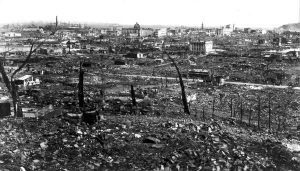August Kengelbacher was a Swiss photographer residing in Tokyo when the earthquake hit. The photographs he took of a ruined Tokyo immediately after the disaster are displayed in a photo exhibit posted online by Peter Kengelbacher (Kengelbacher, “Photographs”). When examined closely, the chaos and destruction portrayed in the pictures dismantle the “economic paradise” façade that the Meiji restoration had given Japan.
The Meiji Restoration
Towards the end of the Sakoku, or isolation period, Japan’s pre-modern economy lagged behind those of industrial global superpowers in the West. In order to keep up, Japan opened its borders to Western influences, marking the beginning of the Meiji Restoration. Between 1868 and 1912, Japan quickly transformed from a feudal to capitalist society. The country assimilated to Western culture and created factories, encouraged trade, and fostered public education. As lifestyles became more commercialized, Japan embarked in a period of “rapid economic growth” that is comparable to the roaring 20s in America. The wide-spread slogan bummei-kaika, or, “civilization and enlightenment” captures the government’s prideful excitement as Japan enjoyed its new economic prosperity (Beasley 1972, p. 2).
The Truth
In reality, while the Meiji restoration increased Japan’s total wealth, most of Japan’s local economies were still semi-industrial, and the market was highly dependent on agriculture, small businesses, and self employment (Hunter 2014, p.754). August Kengelbacher’s photographs reveal that the Meiji restoration only transformed the heart of Tokyo, while the rest of Japan remained frozen in its previous economic dismay.

Buildings largely influenced by Western architecture lined the main streets of Tokyo, such as in the affluent neighborhood of Nihonbashi. These buildings, as shown in Kengelbacher’s photo to the right, were sturdy enough to withstand the tremors and fires from the disaster.

However, there were also images in Kengelbacher’s collection that showed the complete destruction of property. Taken in the few days after the fires, the picture to the left shows two men, dressed in western attire, desperately craning over their burnt property. The juxtaposition of their crisp clothing to the rubble around them is revealing. Even in the midst of disaster, Japanese citizens with-held their image.

As the photo above depicts, the only buildings left standing after the fires were the Western-looking factories and homes in the center of the most wealthy neighborhoods of Tokyo. The immediate outskirts however, were burnt to the ground. This is because, as Japan westernized, urban development only reached the heart of Tokyo, which garnered the most international attention. However, the poor could not afford the new Western houses. Thus, “clustered together out of view along the side streets”, were the ura -nagaya, or “backstreet nagaya” of the lower class (Ishizuka 1979, p.174). These slum dwellings were the same as houses dating back to the Edo period, over two hundred years prior to this disaster. While the buildings in the city were made of masonry and roofed with tile, the dwellings were roofed with flimsy wooden shingles called “kokera”. They housed single tenants and families into packed rows of “narrow, decrepit, wooden tenements” (Ishizuka 1979, p.181). The overcrowding facilitated the spread of epidemics and fire, and caused difficulties such as sewage disposal, delinquency and crime (Ishizuka 1979, p.178). Even though these unsanitary dwellings accounted for sixty percent of the city’s housing units, the rest of the world was blindsided by the prosperous heart of Tokyo.
By simply recording the visual aftermath of the Great Kanto Earthquake, August Kengelbacher unearthed important insight into Japanese culture. Nationalism, or, pride for one’s country drove the government to only fix issues on a surface level. Perhaps if Japan was as modernized as they boasted, not as many would have perished in this disaster. The inability for the country to provide lifestyles they claimed to have ultimately lead to death and destruction that could have been avoided.
*(Kengelbacher, “Photographs”)